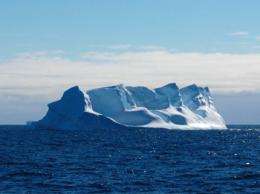Ocean Drilling Expedition off Antarctica May Predict Ice Sheet's Response to Warmer Global Temperatures

(PhysOrg.com) -- New results from a drilling expedition off Antarctica may help scientists learn more about a dramatic turn in climate 34 million years ago, when the planet cooled from a "greenhouse" to an "icehouse" state. In just 400,000 years - a blink of an eye in geologic time - carbon dioxide levels dropped, temperatures plunged and ice sheets formed over what was then the lush continent of Antarctica.
In March, a team of scientists returned from a two-month expedition off Antarctica’s Wilkes Land region with deep sea sediments that promise to shed new light on the continent’s changes in climate over the last 53 million years. The scientists want to learn what sub-tropical Antarctica looked like before the ice (were there palm trees?), and how much the ice sheet has melted and grown back since then.
“Many times in the past, the Earth was as warm as it is predicted to be at the end of this century,” said Trevor Williams, a scientist at Columbia University’s Lamont-Doherty Earth Observatory. “Once we know how stable or unstable the ice was under those conditions, the better we will be able to predict how much, and how fast, the ice may melt in the future.”
Aboard the research ship the JOIDES Resolution, part of the Integrated Ocean Drilling Program, the scientists dodged icebergs, and braved snow, fog and heavy winds to recover more than a mile of sediment cores from the ocean floor. Contained in the sediments are pollen grains that may show what plants lived on a warmer continent, microscopic fossils that provide a record of past sea temperatures and pebbles and gravel that were once ground-up by glaciers and carried to sea by icebergs during periods of past warming.
The low-lying Wilkes Land region is directly south of Australia, in a part of East Antarctica that is especially sensitive to climate change. Though researchers visited this area in the 1970s, the recent expedition was able to bring back a more extensive collection of sediments, covering 53 million years. The sediments include several periods when Earth was as warm as it is projected to be by 2100, including the Pliocene, about 3 million years ago, when Earth was about 5.4 degrees Fahrenheit (3 degrees Celsius) warmer, and sea level up to 80 feet (25 meters) higher. The scientists were also able to retrieve a year-by-year climate record for the last 10,000 years, the relatively warm period when human civilization arose.
“We can read these sediments like a history book,” said co-chief scientist Henk Brinkhuis of Utrecht University, who led the expedition with co-chief scientist Carlota Escutia of the University of Granada. “And this book goes back 53 million years, giving us an unprecedented record of how ice sheets form and interact with changes in the climate and the ocean.”
In the years ahead, the scientists will analyze the cores to understand how climate varied on millennial timescales. The Wilkes Land data will add to research already done in Antarctica over the last 40 years, filling in details about how the ice sheet developed and evolved, and forming the basis for models of future ice sheet behavior and polar climatic change.

For the scientists, iceberg watching from the deck of the JOIDES provided one of the trip’s highlights—a reminder that the processes revealed in an ancient tube of mud dredged from the ocean floor are happening today. “The icebergs come from ice streams that carried ice from the interior of the continent,” said Williams, who works in Lamont’s Borehole Research Group. “They are spectacular, but especially because they are what we are trying to look for in the past.”
Provided by Columbia University


















